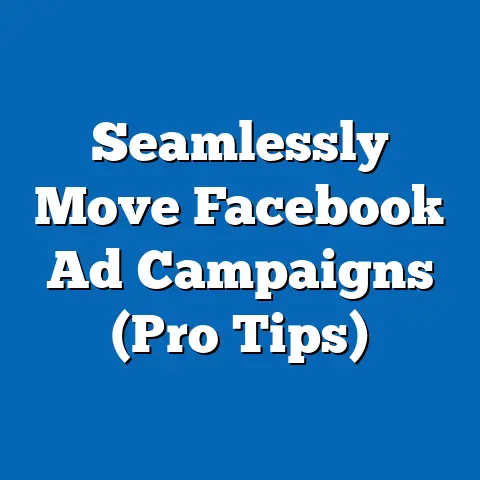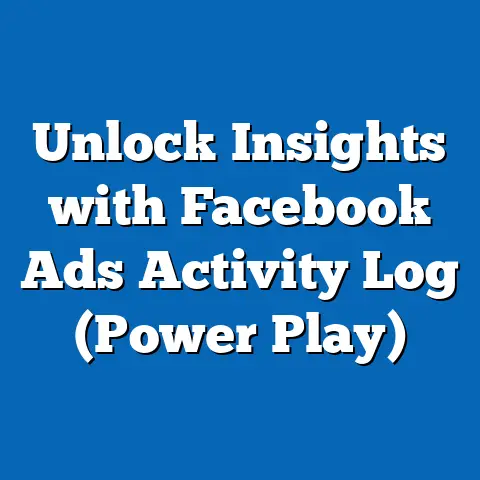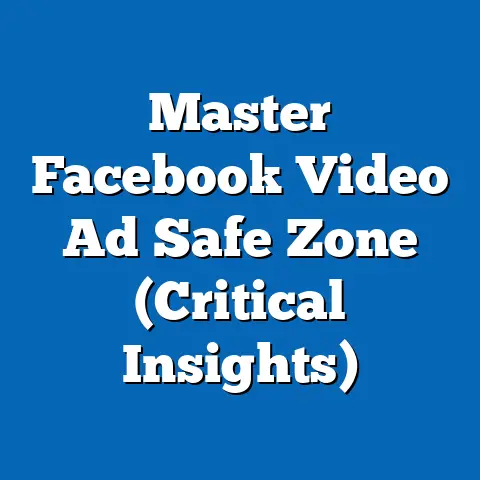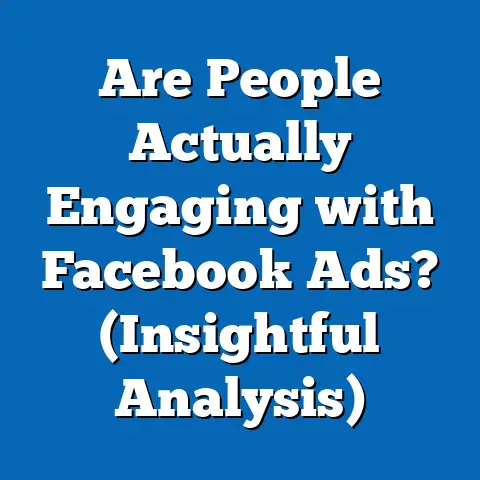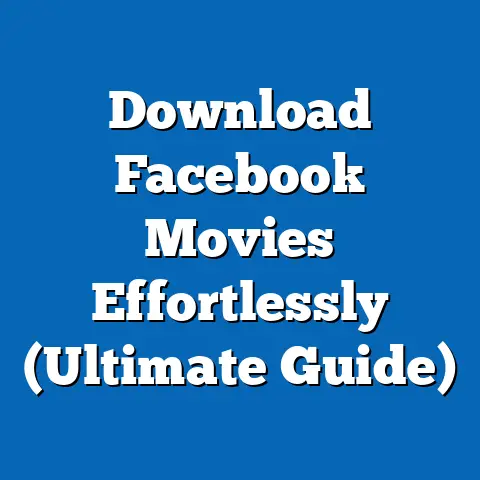Why Is Facebook Flooded with Ads? (Insightful Analysis)
Picture this: I’m scrolling through my Facebook feed, eager to see what my friends and family are up to. I’m a bit of a gardening enthusiast, so I’m also hoping to catch some tips and inspiration from the gardening groups I follow. But what do I see? An endless stream of ads for gardening tools, exotic plant seeds, and even a robotic lawnmower! It’s not just me, is it? Facebook seems to be flooded with ads these days, and it’s not always a pleasant experience.
Facebook, at its core, is designed to connect people with what they love. However, it has also become a powerful advertising platform, meticulously tailoring content to individual users based on their interests. This personalized approach, while potentially useful, often results in an overwhelming presence of advertisements, leaving many of us wondering: Why is Facebook so flooded with ads?
In this article, I’ll dive deep into the reasons behind this phenomenon, exploring the evolution of advertising on Facebook, the mechanics of how these ads work, the psychological principles they leverage, the economic incentives driving businesses, the impact of competition, and how users perceive this ad saturation. Let’s unravel the mystery of the ever-present Facebook ads!
The Evolution of Advertising on Facebook
To understand the current state of advertising on Facebook, I think it’s crucial to take a trip down memory lane. When Facebook first emerged, it was primarily a social networking site focused on connecting people. Advertising was a secondary consideration, if even a consideration at all.
Early Days and Organic Reach
In the beginning, businesses primarily relied on organic reach to connect with their audience. This meant creating engaging content that users would naturally share and interact with, spreading the word about their brand without directly paying for ad space. I remember those days; it felt more authentic, and the content was often more community-driven.
The Introduction of Ads Manager
The game changed with the introduction of Facebook’s Ads Manager. This tool gave businesses unprecedented control over their advertising campaigns, allowing them to target specific demographics, interests, and behaviors. Suddenly, businesses could reach potential customers with laser-like precision.
The Shift to Paid Promotion
As Facebook’s user base grew, organic reach began to decline. This wasn’t a coincidence. Facebook strategically reduced organic reach to encourage businesses to invest in paid advertising. I saw this happen firsthand. Pages that once had a thriving organic presence found their posts reaching fewer and fewer people unless they paid to boost them.
Key Milestones in Facebook’s Advertising Strategy
- 2007: Facebook introduces Facebook Ads, allowing businesses to create basic ads targeting specific demographics.
- 2012: Facebook acquires Instagram, expanding its advertising reach and capabilities.
- 2013: The launch of Power Editor, a more advanced tool for managing large-scale ad campaigns.
- 2015: Facebook introduces the Facebook Pixel, enabling businesses to track conversions and retarget website visitors.
- 2018: Facebook faces scrutiny over data privacy, leading to changes in ad targeting options and transparency.
- Present: Facebook continues to refine its advertising platform, incorporating AI and machine learning to improve ad relevance and performance.
The Transition from Traditional to Digital Advertising
The rise of Facebook advertising coincided with a broader shift from traditional advertising methods to digital platforms. Businesses realized that they could reach a vast audience at a fraction of the cost of traditional media like television, radio, and print. Facebook, with its massive user base and granular targeting capabilities, became a prime destination for advertising dollars.
Takeaway: Facebook’s advertising model has evolved significantly over time, transitioning from a focus on organic reach to a reliance on paid promotions. This shift has been driven by the platform’s desire to monetize its vast user base and provide businesses with powerful tools for targeted advertising.
The Mechanics of Facebook Ads
Now that I’ve covered the evolution of Facebook advertising, let’s delve into the nitty-gritty details of how these ads actually work.
User Data Collection
At the heart of Facebook’s advertising system is its ability to collect and utilize user data. Facebook gathers information from a variety of sources, including:
- Profile Information: Data provided by users when they create their accounts, such as age, gender, location, and education.
- Interests and Activities: Information inferred from users’ interactions on the platform, such as liked pages, joined groups, and shared content.
- Browsing History: Data collected through the Facebook Pixel, which tracks users’ activity on websites outside of Facebook.
- Mobile Data: Information gathered from users’ mobile devices, such as location data and app usage.
Algorithms and Ad Placement
Facebook uses complex algorithms to determine which ads appear in a user’s feed. These algorithms take into account a variety of factors, including:
- User Interactions: Ads are more likely to be shown to users who have previously interacted with similar ads or content.
- Demographic Information: Ads are targeted based on users’ age, gender, location, and other demographic characteristics.
- Interests: Ads are shown to users who have expressed an interest in relevant topics or products.
- Ad Quality: Facebook prioritizes ads that are high-quality and relevant to users, as determined by factors like click-through rate and engagement.
- Bid Amount: Advertisers bid against each other to have their ads shown to specific users, with higher bids generally resulting in greater visibility.
Types of Facebook Ads
Facebook offers a variety of ad formats to cater to different marketing strategies, including:
- Image Ads: Simple ads featuring a single image and accompanying text.
- Video Ads: Engaging ads that capture attention with moving visuals.
- Carousel Ads: Ads that display multiple images or videos in a scrollable format.
- Collection Ads: Ads that showcase a catalog of products, allowing users to browse and purchase directly from the ad.
- Lead Ads: Ads that collect user information, such as email addresses, through a built-in form.
- Instant Experience Ads: Full-screen ads that provide an immersive experience for users.
Takeaway: Facebook’s advertising system relies on the collection and utilization of user data to serve personalized ads. Complex algorithms determine which ads appear in a user’s feed, taking into account factors like user interactions, demographic information, interests, ad quality, and bid amount.
The Psychology Behind Advertising on Social Media
Advertising on Facebook isn’t just about targeting the right demographics. It’s also about understanding the psychological principles that influence user behavior.
Social Proof
One of the most powerful psychological principles at play in social media advertising is social proof. People are more likely to trust and engage with ads that are endorsed by their friends or other trusted sources. Facebook leverages social proof by displaying the number of likes, shares, and comments an ad has received, as well as highlighting when friends have interacted with the ad.
Scarcity
Scarcity is another psychological trigger that can be highly effective in advertising. By creating a sense of urgency or limited availability, advertisers can encourage users to take action. For example, an ad might promote a limited-time offer or highlight the fact that only a few items are left in stock.
Fear of Missing Out (FOMO)
FOMO is a pervasive phenomenon in the age of social media. People are constantly bombarded with images and updates from their friends and acquaintances, leading to a fear of missing out on exciting experiences or opportunities. Advertisers can tap into FOMO by showcasing exclusive products or experiences that users won’t want to miss.
Emotional Triggers
Facebook ads often leverage emotional triggers to increase their effectiveness. Visually appealing content, such as stunning images or heartwarming videos, can evoke positive emotions and make users more receptive to the ad’s message. Similarly, ads that address users’ pain points or aspirations can resonate on a deeper level.
Scroll-Stopping Content
In a crowded digital landscape, advertisers are constantly vying for attention. “Scroll-stopping” content is designed to capture users’ attention and prevent them from mindlessly scrolling past the ad. This can involve using bold visuals, intriguing headlines, or unexpected humor. I’ve found that sometimes, the most unconventional ads are the ones that stick in my mind the longest.
Takeaway: Effective Facebook advertising leverages psychological principles like social proof, scarcity, FOMO, and emotional triggers to influence user behavior. Creating “scroll-stopping” content is essential for capturing attention in a crowded digital landscape.
The Economic Incentives for Businesses
Now, let’s explore why businesses are so eager to flood Facebook with ads. The answer, unsurprisingly, lies in the economic incentives.
Extensive Reach and Diverse User Demographic
Facebook boasts a massive user base, spanning virtually every demographic and geographic location. This makes it an incredibly attractive platform for businesses looking to reach a wide audience. Whether you’re targeting millennials in urban areas or retirees in rural communities, Facebook has you covered.
Cost-Effectiveness
Compared to traditional advertising media like television, radio, and print, Facebook advertising can be incredibly cost-effective. Businesses can set their own budgets and target specific demographics, ensuring that their ad spend is focused on reaching the most relevant audience.
Measurable ROI
One of the biggest advantages of Facebook advertising is its measurability. Businesses can track a wide range of metrics, such as impressions, clicks, conversions, and return on ad spend (ROAS), to assess the effectiveness of their campaigns. This data-driven approach allows businesses to optimize their ad spend and maximize their ROI.
Case Studies
Numerous case studies demonstrate the impact of successful Facebook ad campaigns. For example, a small e-commerce business might use Facebook ads to drive traffic to its website and increase sales. A local restaurant might use Facebook ads to promote its daily specials and attract new customers. The possibilities are endless.
Takeaway: Businesses flood Facebook with ads because of the platform’s extensive reach, cost-effectiveness, and measurable ROI. Successful Facebook ad campaigns can have a significant impact on brand visibility and sales.
The Impact of Competition and Market Trends
The influx of ads on Facebook is also driven by increased competition among businesses and evolving market trends.
Increased Competition
As more and more businesses flock to Facebook advertising, competition for ad space has intensified. This has led to a surge in ad volume, particularly in specific industries like e-commerce, fashion, and health and wellness.
Market Trends and Consumer Behavior Shifts
Market trends and consumer behavior shifts also play a role. For example, during the holiday season, businesses ramp up their advertising efforts to capitalize on increased consumer spending. Similarly, product launches and special events often prompt brands to invest heavily in Facebook ads.
The Role of Influencers and User-Generated Content
Influencers and user-generated content (UGC) have become increasingly important in amplifying advertising efforts on Facebook. Businesses often partner with influencers to promote their products or services to a wider audience. UGC, such as customer reviews and testimonials, can also be highly effective in building trust and credibility.
Takeaway: Increased competition among businesses, evolving market trends, and the rise of influencers and user-generated content have all contributed to the surge in ad volume on Facebook.
The User Experience and Reactions
While businesses benefit from Facebook advertising, it’s important to consider the user experience and how users perceive the influx of ads on their feeds.
Ad Fatigue
One of the biggest challenges of Facebook advertising is ad fatigue. Users can become desensitized to ads over time, leading to a decline in engagement and effectiveness. This is why it’s crucial for advertisers to constantly refresh their creative content and experiment with different ad formats.
The Balance Between Ad Content and Organic Content
Maintaining a balance between ad content and organic content is essential for preserving user engagement and platform loyalty. If users feel like their feeds are being overrun by ads, they may become frustrated and disengage from the platform. Facebook needs to carefully manage the ad load to ensure a positive user experience.
User Attitudes Towards Facebook Advertising
User attitudes towards Facebook advertising vary widely. Some users find ads to be annoying and intrusive, while others appreciate the personalized recommendations and relevant offers. Data and surveys suggest that users are more receptive to ads that are tailored to their interests and provide value.
Takeaway: The influx of ads on Facebook can lead to ad fatigue and negatively impact the user experience. Maintaining a balance between ad content and organic content is essential for preserving user engagement and platform loyalty.
Conclusion
So, why is Facebook flooded with ads? As I’ve explored in this article, the answer is multifaceted. It’s a combination of Facebook’s evolving advertising model, the mechanics of how ads work, the psychological principles they leverage, the economic incentives driving businesses, the impact of competition, and the user experience.
As Facebook continues to evolve in the digital marketing landscape, it will be interesting to see how the platform balances the needs of advertisers with the expectations of users. Will Facebook find a way to deliver more relevant and engaging ads without overwhelming users? Only time will tell.
For now, I encourage you to consider your own relationship with ads in the context of your interests and hobbies. Are the ads you see on Facebook helpful or annoying? Do they provide value or simply clutter your feed? By understanding the forces at play, you can make more informed decisions about how you interact with ads on Facebook and other social media platforms.
Perhaps, as users, we can become more discerning consumers of advertising, rewarding brands that create engaging and relevant content while ignoring those that simply bombard us with irrelevant ads. And maybe, just maybe, we can help shape the future of Facebook advertising for the better.

